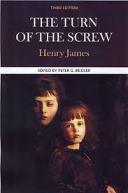 Every year, the RIP challenge encourages bloggers to review Halloween-themed reads (paranormal, mystery, horror). This is my first review for RIP X.
Every year, the RIP challenge encourages bloggers to review Halloween-themed reads (paranormal, mystery, horror). This is my first review for RIP X.
I appreciated Portrait of a Lady, even though I didn’t enjoy it, nor did I sympathize much with its heroine. With this book, however, I may have decided that I dislike James’ writing so much that I won’t attempt any more. Still, it is a classic horror novel and deserves a review.
The Turn of the Screw, published in 1898, has been described as a gothic ghost story novella. It begins with a group of friends telling ghost stories at a party. One of the friends has a ghost story in the form of a manuscript, which he sends for and begins reading. The story is written by a young woman who took a job as a governess with a wealthy man who stipulated that she shouldn’t bother him with any problems she has with the children. The boy, Miles, is away at school, but the girl, Flora, is described as a perfect angel. Miles is sent home by his boarding school with a note that just says that he won’t be able to come back.
The governess begins to see a man and a woman lurking around the house and the grounds. When she describes them, the housekeeper says they must be the former governess, Miss Jessel, and a former employer, Peter Quint. The two were having some kind of relationship when they died. The governess says they are evil and out to get the children, and she starts to see that they’ve already had a malevolent influence on the children.
Everything is told from the perspective of the governess, who seems to jump to a lot of conclusions based on the little she is told by the children and the housekeeper. We never really know who the ghosts are, what they intend, or what the children know.
A lot of the story elements felt like tropes, although they probably were not at the time. For example, the spookily perfect (angelic) children, the strangers peering into the window, and the note for help that (of course) goes astray instead of being delivered.
While the perfect little children are creepy, I felt like the eeriness of the story got really bogged down in James’ long-winded narrative. Very little happens — which was true of Portrait of a Lady as well. However, where Portrait of a Lady felt long because in fact it’s a very long novel, this book is way too short to have felt SO long. Just my two cents.
Also, I found the narrator really annoying. She’s bossy and assumes she’s right about everything; she seems to use the housekeeper’s responses just as a way to confirm what she already thinks.
Although, what’s really interesting about this book is you’re not quite sure whether everything she describes is really happening. Critics have argued about James’ intention with this story. He was known to be a believer in the paranormal (which was quite the fashion at that time) but he creates a structure for this story where no other perspectives can be shared, and even the governess is no longer around to answer questions, suggesting that the mystery is intentional.
If you’re looking for a classic ghost story, you might like this one. I’m not sure James is my cup of tea. I’m reading Shirley Jackson’s We Have Always Lived in the Castle, and I’ll definitely take that one for creepiness.
By the way, what do you think of this cover? I saw a lot of them but this one felt the most reflective of the book.

